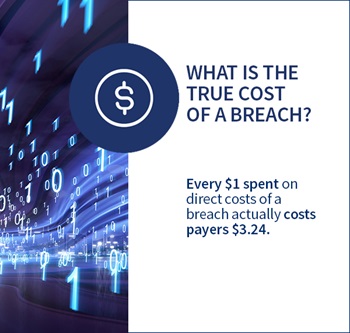Payer Cost of Healthcare Data Breaches
2022 Report for Healthcare Data Security
The costs associated with healthcare cyberattacks and breaches can be high.
You’ve likely heard more and more about healthcare data breaches. No target seems completely safe with cybercriminals going after hospitals, private physician practices, payers and many other organizations.
But you may not know why payers are particularly vulnerable to these digital threats, how much it’s costing payers from small to large, and strategies that health plans use to improve their chances of minimizing damage to their staff, company and members.
So why payers and why now? The new “True Cost of Fraud™ for Healthcare Payers” report from LexisNexis® Risk Solutions highlights some leading reasons.
 The rise of healthcare consumerism during the COVID-19 pandemic, for example, has many members expecting greater access to their health information online. Also, the more players seeing and storing healthcare data, the higher the chances a bad actor will find a vulnerability to exploit.
The rise of healthcare consumerism during the COVID-19 pandemic, for example, has many members expecting greater access to their health information online. Also, the more players seeing and storing healthcare data, the higher the chances a bad actor will find a vulnerability to exploit.
For health plans in particular, the “True Cost of Fraud™ for Healthcare Payers” report reveals:
#1. Why newer channels can create more risk for payers
#2. The three leading types of attacks
#3. The average cost of a data breach, in millions of dollars
#4. A key challenge for payers related to identity verification
#5. A multi-layered strategy considered essential for detecting and containing cyberbreaches
Time is also of the essence with a healthcare data breach. Detecting and responding earlier to a cyber threat can help limit the damage it causes, the report emphasizes.
Healthcare Data Breaches are Costly and Common
Cyberattack strikes cause a lot of immediate anxiety and fear. Healthcare organization leaders scramble to answer some basic questions: What data has been compromised or lost? How extensive is the breach? What can we do to mitigate the damage? How should we alert our members?
Cyberattacks can also cause long-lasting issues for a payer. Current health plan members might move to another health plan in the wake of an attack, no longer trusting your organization to protect their private information. Future members might steer clear. After such losses, it can become challenging and costly to rebuild membership numbers.
Our report quantifies the steep cost of losing members. Across the top 100 healthcare payers, for example, the average cost of acquiring each new member is more than 300% times higher than retaining one.
One thing is very clear – healthcare is a favorite target for cybercriminals now. The high value of personal health and financial information to the dark web is a prime reason. This reality – combined with an industry lagging behind others in putting up effective defenses – means payers and other healthcare players still have work to do.
Digital data continues to drive healthcare in new directions. So it’s more important than ever to stay ahead of any nefarious players and strengthen your cybersecurity protections.
Learn more by downloading the “True Cost of Fraud for Healthcare Payers” report.
Access Full Research Here
Products You May Be Interested In
-
InstantID® Q&A for Healthcare
Seamlessly verifies the identity of patients, medical staff and pharmacists.
Learn More -
ThreatMetrix® for Healthcare
Analyze millions of transactions in near real-time across billions of devices for secure access to sensitive health information.
Learn More -
TrueID® Mobile for Healthcare
TrueID® Mobile for Healthcare
Learn More
